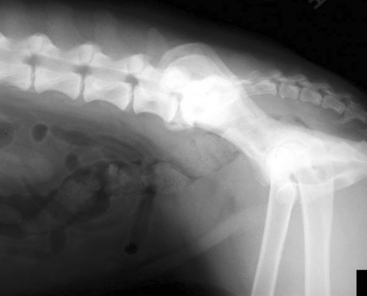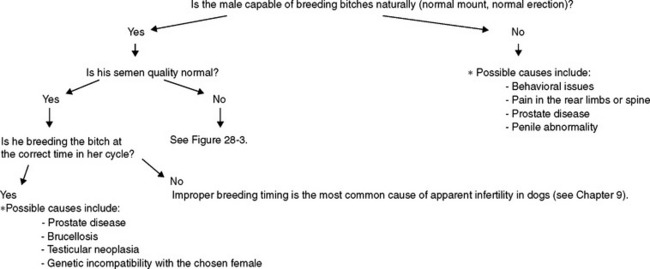28 Infertility
Infertility in male dogs can occur from many causes (Figure 28-1). If the male is not capable of mounting and breeding the bitch, physical or behavioral problems may be at fault (Figure 28-2). If he is capable of breeding the bitch and has normal semen quality, appropriate timing of breeding should be investigated. Inappropriate breeding timing is by far the most common cause of apparent infertility in dogs (see Chapter 9). If he has normal semen quality and breeding management has been adequate, possible causes of infertility include prostate disease (see Chapter 26), brucellosis (see Chapter 20), testicular neoplasia (see Chapter 25), and genetic incompatibilities with the female.

Figure 28-2 Radiograph demonstrating spinal arthritis in male dog with decreased libido due to pain.
If the male is capable of breeding the bitch but does not have normal semen quality, as determined by semen evaluation, specific causes for poor semen quality must be addressed (Figure 28-3). Although abnormalities of spermatozoa will be described as separate entities, be aware that often a single problem will cause multiple abnormalities; for example, anything that causes an increase in abnormally shaped spermatozoa is likely to cause a decrease in percentage motile spermatozoa because the abnormally shaped spermatozoa are unlikely to have normal motility.
Azoospermia is lack of spermatozoa in the ejaculate. The dog ejaculates clear fluid. Causes can arise from before the testis, at the testis, or after the testis. Causes from before the testis include apprehension, hypothyroidism (see Chapter 6), and drug therapy that decreases spermatogenesis (Table 28-1). Causes from the level of the testis include abnormalities of sexual development (Figure 28-4), bilateral cryptorchidism (see Chapter 25), high fever in the previous 2 months or earlier, trauma in the previous 2 months or earlier, and testicular neoplasia (see Chapter 25). A cause arising after the testis is bilateral is occlusion of the epididymis. Testing of dogs with azoospermia usually starts with measurement of the enzyme alkaline phosphatase (ALP) in the sperm-free fluid collected by ejaculation. ALP in seminal fluid arises from the epididymis. If the concentration of ALP is low in seminal fluid, that suggests that no fluid was collected from the testes and the dog may well be capable of making spermatozoa. If the concentration of ALP in seminal fluid containing no spermatozoa is high, that suggests that the ejaculate does contain fluid from the testes and epididymes and prognosis is worse for return to function.
Table 28-1 Drugs Associated with Decreased Spermatogenesis in Male Dogs
| Drug Class | Specific Drugs |
|---|---|
| Glucocorticoids (steroids) | |
| Anabolic steroids | — |
| Estrogens | |
| Androgens | Testosterone |
| Progestogens | Medroxyprogesterone acetate |
| Chemotherapy drugs | — |
| Antifungal drugs | < div class='tao-gold-member'> Only gold members can continue reading. Log In or Register to continue
Stay updated, free articles. Join our Telegram channel
Full access? Get Clinical Tree
 Get Clinical Tree app for offline access
Get Clinical Tree app for offline access

|

